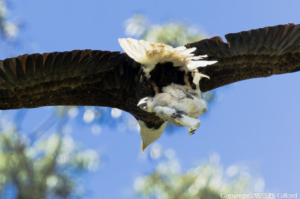Cost-effective and quick to install, wind turbines seem to be a leader in the race to develop clean, renewable energy sources. But at the Altamont Pass Wind Resource Area east of Livermore, the country’s largest and oldest wind farm site is also the most deadly for wildlife, killing thousands of birds annually.
The Altamont, a major migratory corridor, hosts large raptor populations, including one of the world’s highest densities of breeding golden eagles. When wind turbines were installed here in the 1980s, their blades’ lethal effects were little known. But for more than 25 years, Altamont’s 5,400 turbines have been killing up to 4,700 birds annually–as many as 1,300 of them raptors.
Many of the birds killed here–including golden eagles, red-tailed hawks, and burrowing owls–are supposed to be protected by state and federal laws, which have not been enforced. In 2003 and 2004, the Golden Gate Audubon Society (GGAS), Californians for Renewable Energy (CARE), and the Center for Biological Diversity (CBD) unsuccessfully appealed Alameda County’s renewal of wind farm permits. Though some conditions were added in 2005, Golden Gate Audubon and CARE sued the county and the wind companies for inadequate environmental review. In 2007, they settled the suit with a controversial plan to reduce kills 50 percent by late 2009.
However, subsequent research suggests the plan is not reducing mortality. A recent study led by East Bay Regional Park District Wildlife Program Manager Doug Bell and consulting wildlife ecologist K. Shawn Smallwood indicates mortality rates in the Altamont are even higher than previously thought. Based on his extensive observations, Bell believes raptors will be at risk even with taller turbines often touted as less deadly to birds.
District biologists hope their findings on raptor flight behavior will lead to changes in turbine placement and operation that will reduce the number of kills. They are also continuing research on vegetation management to discourage small mammals from living around turbines, which would in turn reduce raptor hunting in the area. In the meantime, illegal and unmitigated bird kills continue as the turbines spin in the Altamont.
Online resources: GGAS (www.goldengateaudubon.org), CBD (www. biologicaldiversity.org), American Wind Energy Association (www.awea.org), and California Energy Commission (www.energy.ca.gov).

.jpg)



